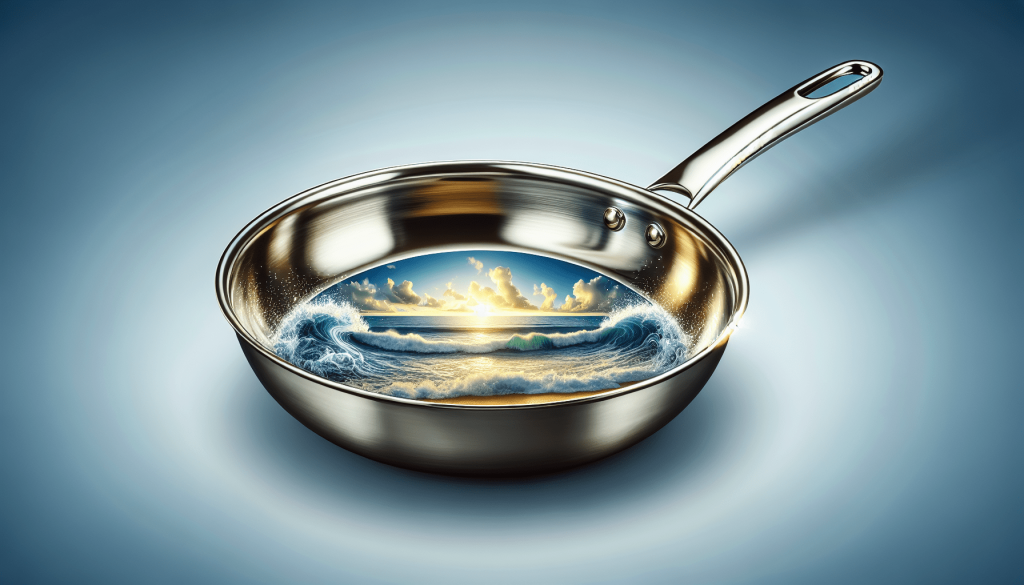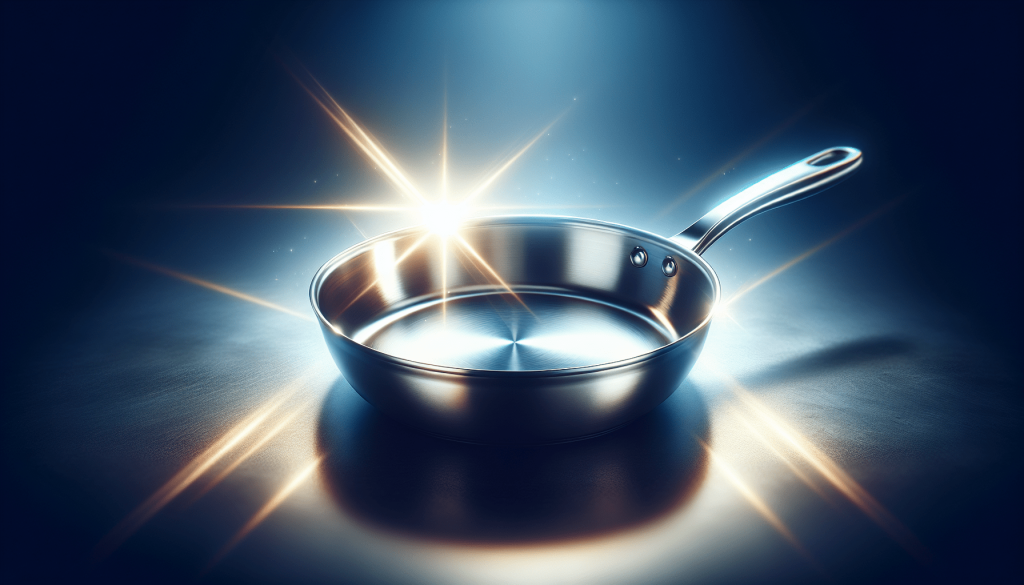So you’ve decided to explore the world of cooking and embark on a culinary journey? Well, congratulations! But before you perfect your recipes and impress your friends and family, you need to ensure you have the right cookware to accompany your skills. Choosing the right cookware can make a world of difference in your cooking experience, enhancing flavors and ensuring efficient cooking. Don’t worry, though – this beginner’s guide will walk you through everything you need to know to select the perfect cookware that suits your unique cooking style. From pots and pans to materials and features, get ready to equip yourself with the essentials to become a master in the kitchen.

Understanding Different Types of Cookware
When it comes to choosing cookware, the options can be overwhelming. From nonstick to stainless steel, cast iron to copper, each type of cookware has its own unique advantages and disadvantages. To make an informed decision, it’s important to understand the characteristics of each type and how they align with your cooking style.
Consider Your Cooking Style
Before diving into the details of each type of cookware, take a moment to consider your cooking style. Understanding your frequency of cooking, the types of dishes you usually prepare, and the cooking techniques you prefer will help you determine which type of cookware is best suited for you.
Frequency of Cooking
Think about how often you cook. Are you an avid home cook who creates delicious meals every day, or do you only cook occasionally? If you find yourself spending a significant amount of time in the kitchen, durability and longevity should be key factors in your decision-making.
Types of Dishes You Cook
Consider the types of dishes you enjoy making. Do you mostly whip up stir-fries and scrambled eggs? Or do you prefer slow-cooking hearty stews and casseroles? Different types of cookware excel at different cooking methods, so understanding your preferred dishes will help guide your choice.
Cooking Techniques You Use
Think about the cooking techniques you frequently use. Are you an expert at searing and sautéing, or do you lean towards gentle simmering and braising? Certain types of cookware are better suited for specific techniques, so it’s important to match your cookware to your preferred methods.
Choosing Cookware Based on Material
The material of your cookware plays a crucial role in determining its performance, heat conductivity, durability, and maintenance requirements. Let’s take a closer look at the materials commonly used in cookware.
Heat Conductivity
Heat conductivity refers to how quickly and evenly heat is distributed throughout the cookware. Materials like copper and aluminum excel in this area, allowing for precise temperature control and even cooking. Stainless steel and cast iron have lower heat conductivity but can still provide excellent results with proper preheating.
Durability and Longevity
Consider the durability and longevity of your cookware. Stainless steel is known for its exceptional durability and resistance to corrosion, making it a popular choice among many home cooks. Cast iron is also highly durable, but it requires regular seasoning to maintain its longevity. Nonstick cookware, on the other hand, is prone to scratching and may need to be replaced more frequently.
Maintenance and Care
Different types of cookware have varying maintenance and care requirements. Nonstick cookware is often easier to clean, but it requires gentle utensils and careful use to prevent scratching. Stainless steel is generally dishwasher safe and easy to clean, while cast iron requires special care and regular seasoning. Consider how much time and effort you’re willing to invest in maintaining your cookware.

Nonstick Cookware
Nonstick cookware is a popular choice for many home cooks due to its convenience and ease of use.
Advantages of Nonstick Cookware
The main advantage of nonstick cookware is its ability to prevent food from sticking to the surface. This makes it ideal for cooking delicate foods like eggs, pancakes, and fish. Nonstick surfaces also require less oil or fat, resulting in healthier cooking options. Cleaning nonstick cookware is a breeze, as food residues are less likely to cling to its surface.
Disadvantages of Nonstick Cookware
Nonstick cookware does have its limitations. High heat and metal utensils can damage the nonstick coating, leading to potential health risks if the coating flakes off. For this reason, nonstick cookware may not be suitable for high-heat cooking methods or for use with metal utensils. Additionally, the nonstick coating may wear off over time and require replacement.
Best Uses of Nonstick Cookware
Nonstick cookware shines in tasks that require easy food release. From omelettes to stir-fries, nonstick pans are perfect for cooking delicate ingredients that are prone to sticking. It’s important to use nonstick cookware responsibly at lower to medium heat settings and avoid using metal utensils to prolong its lifespan.
Stainless Steel Cookware
Stainless steel cookware is a versatile and durable option suitable for a wide range of cooking styles.
Advantages of Stainless Steel Cookware
One of the major advantages of stainless steel cookware is its durability. It can withstand high heat and is resistant to staining and corrosion. Stainless steel is also non-reactive, meaning it won’t leach any metallic taste or react with acidic ingredients. Its sleek appearance adds a professional touch to your kitchen, and many stainless steel pots and pans are induction-compatible.
Disadvantages of Stainless Steel Cookware
Despite its many advantages, stainless steel cookware has a few drawbacks. One major challenge is its poor heat conductivity compared to other materials. Without proper preheating, you may experience uneven cooking. Additionally, stainless steel can be prone to food sticking, especially when dealing with delicate foods like fish or eggs.
Best Uses of Stainless Steel Cookware
Stainless steel cookware is well-suited for a variety of cooking techniques. It excels in tasks that require high heat, such as searing and browning meat. Stainless steel pots are great for boiling pasta or simmering soups and sauces. To prevent food from sticking, properly preheat the pan and use sufficient oil or fat.
Cast Iron Cookware
Cast iron cookware has been used for centuries and is renowned for its exceptional heat retention and versatility.
Advantages of Cast Iron Cookware
The main advantage of cast iron cookware is its ability to retain and distribute heat evenly. Cast iron pans can withstand high temperatures and are suitable for both stovetop and oven cooking. They can be used on any heat source, including induction stovetops. Cast iron is also naturally nonstick when properly seasoned, providing excellent food release and easy cleanup.
Disadvantages of Cast Iron Cookware
Despite its many advantages, cast iron cookware does have a few downsides. It is heavy and requires some effort to lift and maneuver. Cast iron also requires regular seasoning to maintain its nonstick properties and prevent rusting. Improper cleaning, such as using harsh soaps, can damage the seasoning. Additionally, acidic ingredients may react with the iron and affect the taste of the food.
Best Uses of Cast Iron Cookware
Cast iron cookware is incredibly versatile and suitable for a wide array of cooking techniques. It excels in tasks that require even heat distribution and controlled cooking, such as frying, baking, or braising. Cast iron skillets are perfect for searing steaks or sautéing vegetables, while dutch ovens are ideal for slow-cooking hearty stews and roasts.
Copper Cookware
Copper cookware is prized for its exceptional heat conductivity and exquisite aesthetic appeal.
Advantages of Copper Cookware
Copper is one of the best heat conductors, allowing for precise temperature control and even cooking. This makes copper cookware a favorite among professional chefs. Its quick response to changes in heat ensures consistent results. Copper pans also have a beautiful, classic appearance that adds a touch of elegance to your kitchen.
Disadvantages of Copper Cookware
While copper cookware offers excellent cooking performance, there are a few downsides to consider. Copper is a reactive metal and can interact with certain acidic ingredients, causing a metallic taste. To counter this, most copper cookware is lined with another metal, such as stainless steel or tin. Proper maintenance is essential to prevent tarnishing and preserve the cookware’s appearance.
Best Uses of Copper Cookware
Copper cookware is highly versatile and well-suited for various cooking techniques. Copper saucepans and pots are excellent for precise heating and simmering delicate sauces. Sautéing and pan-frying can also be done flawlessly in copper pans. Ensure that the lining is intact and that you follow the manufacturer’s care instructions to fully enjoy the benefits of copper cookware.
Choosing Cookware Sets versus Individual Pieces
Once you’ve decided on the type of cookware that suits your cooking style, it’s time to determine whether purchasing a cookware set or individual pieces is the right choice for you.
Advantages of Cookware Sets
Cookware sets offer convenience and a comprehensive range of essential pieces. With a set, you’ll have the basics covered, including saucepans, frying pans, and sometimes additional items like a stockpot or a skillet. Sets often come at a more affordable price compared to purchasing individual pieces separately.
Advantages of Individual Pieces
Choosing individual pieces allows you to tailor your cookware collection to your specific needs. This approach is ideal if you have certain dishes or cooking techniques that require specialized cookware. It also gives you the flexibility to gradually build your collection over time.
Considerations for Choosing Sets vs Individual Pieces
When deciding between a cookware set and individual pieces, consider your cooking habits, available storage space, and budget. If you’re a beginner or need a complete range of cookware, sets can be a cost-effective option. However, if you have unique cooking preferences or limited storage, purchasing individual pieces may be more suitable.
Matching Cookware to Your Stovetop
Different types of stovetops require compatible cookware materials for optimal performance and safety.
Induction Stovetops
If you have an induction stovetop, you’ll need cookware with magnetic properties for it to work effectively. Stainless steel, enameled cast iron, and some copper cookware with an induction-compatible base are ideal choices for induction stovetops.
Gas Stovetops
Gas stovetops provide instant and precise heat control, making them versatile and suitable for any type of cookware. You have the freedom to choose from a wide range of materials, including stainless steel, cast iron, copper, and nonstick.
Electric Stovetops
Electric stoves, whether coil or smooth top, require cookware with good heat conductivity for efficient cooking. Stainless steel, cast iron, and copper are all excellent options for electric stovetops. However, avoid using nonstick cookware on electric coils, as the high heat can damage the nonstick coating.
Budget Considerations
Setting a budget for your cookware purchase helps narrow down your options and ensures you make a financially responsible decision.
Setting Your Budget
Determine how much you’re willing to spend on cookware. The prices can vary significantly depending on the brands, materials, and quality. A well-designed and durable set can be a long-term investment, so consider your budget in relation to the lifespan and performance of the cookware.
Prioritizing Essential Cookware Pieces
If your budget is limited, prioritize the essential cookware pieces that you’ll frequently use. A few versatile items like a skillet, a saucepan, and a stockpot can cover a wide range of cooking needs. You can gradually add additional pieces to your collection over time.
Exploring Affordable Options
Cookware doesn’t have to break the bank. There are many affordable options available that provide good performance and quality within a reasonable budget. Consider reputable brands that offer affordable lines or look for sales and discounts. Thrift stores and online marketplaces may also have second-hand cookware in good condition at a fraction of the cost.
Choosing the right cookware for your cooking style is an essential step towards elevating your culinary experience. By understanding the different types of cookware, their advantages and disadvantages, and how they align with your preferences, you can make an informed decision. Whether you opt for nonstick, stainless steel, cast iron, or copper, the right cookware will enhance your cooking abilities and inspire you to create delicious meals with ease. So go ahead, equip your kitchen with the perfect cookware, and let your culinary journey begin!
